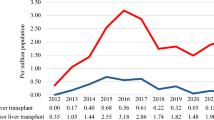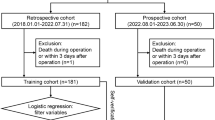Abstract
In the past, organ allocation in the US was based on anecdotal experience, self-interest and the opinions of single centers, with little support in the way of scientific evidence, mathematical survival modeling or validation. As organ transplantation became more successful, and as disparity between the number of patients on the waiting list and available organs became larger, a more justifiable donor allocation scheme became necessary. The current allocation scheme for donor livers is based on the model for end-stage liver disease/pediatric end-stage liver disease, which was introduced in 2002 by the United Network for Organ Sharing. This new allocation system has improved accuracy for predicting pretransplant mortality. In addition, the number of liver transplantations has risen for almost all etiologic categories, most noticeably for patients with hepatocellular carcinoma. Fewer patients have been registered on the liver transplant waiting list and fewer have been removed from the list because they have died or become too sick for transplantation. So far, this new allocation system has been a success, but it does have its shortcomings, and even with improvements to the system, the use of the donor organ pool still needs to be optimized.
This is a preview of subscription content, access via your institution
Access options
Subscribe to this journal
Receive 12 print issues and online access
$209.00 per year
only $17.42 per issue
Buy this article
- Purchase on Springer Link
- Instant access to full article PDF
Prices may be subject to local taxes which are calculated during checkout

Similar content being viewed by others
References
Freeman RB et al. (2004) Improving liver allocation: MELD and PELD. Am J Transplant 4 (Suppl 9): 114–131
Lucey MR et al. (1997) Minimal criteria for placement of adults on the liver transplant waiting list: a report of a national conference organized by the American Society of Transplant Physicians and the American Associations for the Study of Liver Diseases. Liver Transpl Surg 3: 628–637
United Network for Organ Sharing (online) Components of the CTP score employed in the previous liver allocation policy [www.unos.org] (accessed July 31, 2002)
Institute of Medicine (1999) Analysis of waiting time. In Committee on Organ Transplantation: Assessing Current Policies and the Potential Impact of the DHHS Final Rule, 57–78 Washington DC: National Academy Press
Freeman R and Edward E (2000) Liver transplant waiting time does not correlate with waiting list mortality: implications for liver allocation policy. Liver Transpl 6: 543–552
Wiesner RH et al. (2001) MELD and PELD: Application of survival models in liver allocation. Liver Transpl 7: 567–580
Organ procurement and transplantation network-HRSA (1998) Final rule with comment period. Fed Reg 63: 16296–16338
Committee on Organ Procurement and Transplantation Policy (1999) In Organ Procurement and Transplantation: Assessing Current Policies and the Potential Impact of the DHHS Final Rule, 82 Washington DC: National Academy Press
Malinchoc M et al. (2000) A model to predict poor survival in patients undergoing transjugular intrahepatic portosystemic shunts. Hepatology 31: 865–871
Kamath PS et al. (2001) A model to predict survival in patients with end-stage liver disease. Hepatology 33: 464–470
Hanley JA and McNeil BJ (1982) The meaning and use of the area under a receiver operating characteristic (ROC) curve. Radiology 143: 29–36
Wiesner R et al. (2003) The model for end-stage liver disease (MELD), allocation of donor livers. Gastroenterology 124: 91–96
McDiarmid SV et al. (2002) Development of a pediatric end-stage liver disease score to predict poor outcome awaiting liver transplantation. Transplantation 74: 173–181.
Mazzaferro V et al. (1996) Liver transplantation for the treatment of small hepatocellular carcinomas in patients with cirrhosis. N Engl J Med 334: 693–699
Yao FY et al. (2003) A follow-up analysis of the pattern and predictors of dropout from the waiting list for liver transplantation in patients with hepatocellular carcinoma: implications for the current organ allocation policy. Liver Transpl 9: 684–692
Freeman RB et al. (2004) Results of the first year of the new liver allocation plan. Liver Transpl 10: 7–15
Sharma P et al. (2004) Liver transplantation for hepatocellular carcinoma: the MELD impact. Liver Transpl 10: 36–41
Wiesner RH et al. (2004) Liver transplantation for hepatocellular cancer: impact of the MELD allocation policy. Gastroenterology 127 (Suppl 1): 5261–5267
Magee J et al. (2004) Pediatric transplantation. Am J Transplant 4 (Suppl 9): 54–71
Merion RM et al. (2004) The survival benefit of liver transplantation. Am J Transplant 4 (Suppl 8): 308
Trotter JF et al. (2004) Specific laboratory methodologies: achieve higher model for end-stage liver disease (MELD) scores for patients listed for liver transplantation. Liver Transpl 10: 995–1000
Olthoff KM et al. (2004) Evolving concepts in liver allocation in the MELD/PELD era: summary report of a national conference. Liver Transpl 10 (Suppl 2): A6–A22
Yantorno E et al. (2004) Addition of serum sodium into the MELD score predicts waiting time mortality better than MELD alone: a single center experience. Am J Transplant 4 (Suppl 8): 438
Trotter JF and Osgood MJ (2004) MELD scores of liver transplant recipients according to size of waiting list: Impact of organ allocation and patient outcomes. JAMA 291: 1971–1874
Feng S et al. (2003) Definition and outcome of transplants using expanded criteria donor livers. Hepatology 38: 158A
Organ Donation Breakthrough Collaborative (online) Charter (pdf) [www.natcol.org/collaborative] (accessed 1 August 2004).
Author information
Authors and Affiliations
Corresponding author
Ethics declarations
Competing interests
The author declares no competing financial interests.
Rights and permissions
About this article
Cite this article
Wiesner, R. Patient selection in an era of donor liver shortage: current US policy. Nat Rev Gastroenterol Hepatol 2, 24–30 (2005). https://doi.org/10.1038/ncpgasthep0070
Received:
Accepted:
Issue Date:
DOI: https://doi.org/10.1038/ncpgasthep0070
This article is cited by
-
Outcomes of Liver Transplant Candidates with Primary Biliary Cholangitis: The Data from the Scientific Registry of Transplant Recipients
Digestive Diseases and Sciences (2020)
-
Prioritization for liver transplantation
Nature Reviews Gastroenterology & Hepatology (2010)
-
Limitations of the MELD score in predicting mortality or need for removal from waiting list in patients awaiting liver transplantation
BMC Gastroenterology (2009)



